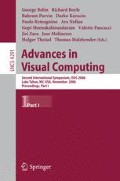Abstract
This paper presents a computational model of stylistic similarity between human motions that is statistically derived from a comprehensive collection of captured, stylistically similar motion pairs. In this model, a set of hypersurfaces learned by single-class SVM and kernel PCA characterize the region occupied by stylistically similar motion pairs in the space of all possible pairs. The proposed model is further applied to a system for adapting an existing clip of human motion to a new environment, where stylistic distortion is avoided by enforcing stylistic similarity of the synthesized motion to the existing motion. The effectiveness of the system has been verified by 18 distinct adaptations, which produced walking, jumping, and running motions that exhibit the intended styles as well as the intended contact configurations.
Access this chapter
Tax calculation will be finalised at checkout
Purchases are for personal use only
Preview
Unable to display preview. Download preview PDF.
References
Witkin, A., Kass, M.: Spacetime constraints. In: SIGGRAPH, pp. 159–168 (1988)
Schölkopf, B., Platt, J.C., Shawe-Taylor, J., Smola, A.J., Williamson, R.C.: Estimating the support of a high-dimensional distribution. Neural Computation 13, 1443–1471 (2001)
Schölkopf, B., Smola, A., Müller, K.R.: Nonlinear component analysis as a kernel eigenvalue problem. Neural Computation 10, 1299–1319 (1998)
Liu, C.K., Popović, Z.: Synthesis of complex dynamic character motion from simple animations. In: SIGGRAPH, pp. 408–416 (2002)
Grochow, K., Martin, S.L., Hertzmann, A., Popović, Z.: Style-based inverse kinematics. ACM Trans. Graph. 23, 522–531 (2004)
Arikan, O., Forsyth, D.A., O’Brien, J.F.: Motion synthesis from annotations. ACM Transactions on Graphics (TOG) 22, 402–408 (2003)
Ben-Arie, J., Wang, Z., Pandit, P., Rajaram, S.: Human activity recognition using multidimensional indexing. IEEE Trans. Pat. Anal. Mach. Intel. 24, 1091–1104 (2002)
Rao, C., Yilmaz, A., Shah, M.: View-invariant representation and recognition of actions. International Journal of Computer Vision 50, 203–226 (2002)
Gleicher, M.: Motion editing with spacetime constraints. In: Proceedings of the 1997 symposium on Interactive 3D graphics, p. 139 (1997)
Gleicher, M.: Retargetting motion to new characters. In: SIGGRAPH, pp. 33–42 (1998)
Lee, J., Shin, S.Y.: A hierarchical approach to interactive motion editing for human-like figures. In: SIGGRAPH, pp. 39–48 (1999)
Popović, Z., Witkin, A.: Physically based motion transformation. In: SIGGRAPH (1999)
Sulejmanpašić, A., Popović, J.: Adaptation of performed ballistic motion. ACM Trans. Graph. 24, 165–179 (2005)
Tak, S., Ko, H.S.: A physically-based motion retargeting filter. ACM Trans. Graph. 24 (2005)
Pollard, N.S., Behmaram-Mosavat, F.: Force-based motion editing for locomotion tasks. In: Proceedings of the IEEE International Conference on Robotics and Automation (2000)
Pollard, N.S.: Simple machines for scaling human motion. In: Computer Animation and Simulation 1999 (1999)
Liu, C.K., Hertzmann, A., Popović, Z.: Learning physics-based motion style with nonlinear inverse optimization. ACM Trans. Graph. 24, 1071–1081 (2005)
Fod, A., Matarić, M.J., Jenkins, O.C.: Automated derivation of primitives for movement classification. Autonomous Robots 12, 39–54 (2002)
Fang, A.C., Pollard, N.S.: Efficient synthesis of physically valid human motion. ACM Transactions on Graphics (TOG) 22, 417–426 (2003)
de Leva, P.: Adjustments to Zatsiorsky-Seluyanov’s segment inertia parameters. J. Biomechanics 29, 1223–1230 (1996)
Schittkowski, K.: Solving constrained nonlinear least squares problems by a general purpose SQP-method. In: Hoffmann, K.H., et al. (eds.) Trends in Math. Optim., pp. 295–309 (1988)
Gill, P.E., Murray, W., Saunders, M.A.: SNOPT: An SQP algorithm for large-scale constrained optimization. Technical Report NA–97–2, Dept. Mathematics, UCSD (1997)
Author information
Authors and Affiliations
Editor information
Editors and Affiliations
Rights and permissions
Copyright information
© 2006 Springer-Verlag Berlin Heidelberg
About this paper
Cite this paper
Chien, YR., Liu, JS. (2006). Learning the Stylistic Similarity Between Human Motions. In: Bebis, G., et al. Advances in Visual Computing. ISVC 2006. Lecture Notes in Computer Science, vol 4291. Springer, Berlin, Heidelberg. https://doi.org/10.1007/11919476_18
Download citation
DOI: https://doi.org/10.1007/11919476_18
Publisher Name: Springer, Berlin, Heidelberg
Print ISBN: 978-3-540-48628-2
Online ISBN: 978-3-540-48631-2
eBook Packages: Computer ScienceComputer Science (R0)

